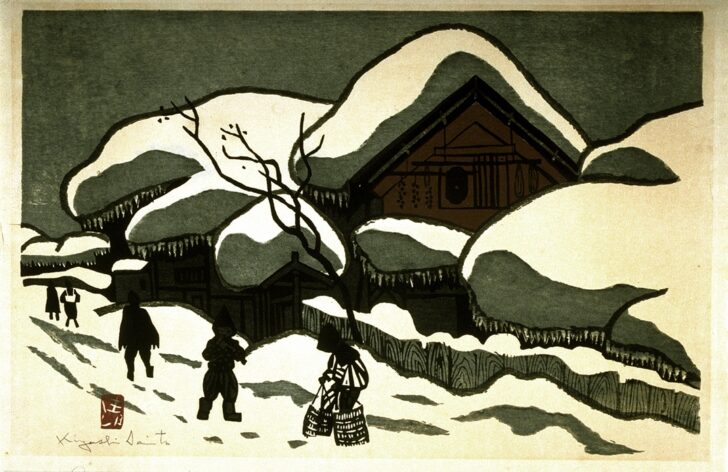Gasshôzukuri Farmhouses in Snow
Saitō Kiyoshi

Description
The Creative Print (sôsaku hanga) movement played a strategic role in the transformation of American-Japanese relations during the Cold War. In the decades before and after the Second World War Americans were receiving conflicting messages about Japan, which was successively presented as an exotic land of geisha, an increasingly evil adversary of America and its culture, and finally as a much-needed ally against communism in Asia. Post-war, the people of the United States and Japan were encouraged by their governments to embrace one another as friends (although with America occupying Japan until the 1950s, this friendship was less than equal) and art was considered an attractive vehicle for promoting this political goal. Already popular among occupying forces, the work of Creative Print artists appealed to the larger American audience because it both resonated with nostalgic pre-war conceptions of Japan and was infused with a modern sensibility.
This modern presentation of traditional Japan is one that the versatile Saitô captured masterfully in his work. Famous places in Japan were one of the most popular subjects of Edo (1615–1868) and Meiji (1868–1912) period woodblock prints, and Creative Print artists strove to represent them in innovative ways. A native of Sakamoto in Fukushima Prefecture, here Saitô used the snow-covered imagery of his far northern hometown to present a view of Japan that drew on the past yet was visually fresh.
(Gallery Rotation Fall 2011)
Gallery Rotation Fall 2011
Saitô Kiyoshi
Japan, 1907–1997
Buddha (B)
1959
Showa period (1926–89)
Color woodblock print on paper
Gift of Dr. Lawrence Preuss, 1987/1.240
Gasshôzukuri Farmhouses in Snow
ca. 1958
Showa period (1926–89)
Color woodblock print on paper
Gift of Mr. and Mrs. Robert Honer, 1994/2.4
The Creative Print (sôsaku hanga) movement played a strategic role in the transformation of American-Japanese relations during the Cold War. In the decades before and after the Second World War Americans were receiving conflicting messages about Japan, which was successively presented as an exotic land of geisha, an increasingly evil adversary of America and its culture, and finally as a much-needed ally against communism in Asia. Post-war, the people of the United States and Japan were encouraged by their governments to embrace one another as friends (although with America occupying Japan until the 1950s, this friendship was less than equal) and art was considered an attractive vehicle for promoting this political goal. Already popular among occupying forces, the work of Creative Print artists appealed to the larger American audience because it both resonated with nostalgic pre-war conceptions of Japan and was infused with a modern sensibility.
This modern presentation of traditional Japan is one that the versatile Saitô captured masterfully in his work. Famous places in Japan were one of the most popular subjects of Edo (1615–1868) and Meiji (1868–1912) period woodblock prints, and Creative Print artists strove to represent them in innovative ways. A native of Sakamoto in Fukushima Prefecture, here Saitô used the snow-covered imagery of his far northern hometown to present a view of Japan that drew on the past yet was visually fresh.
Subject Matter:
The artist was a member of the Creative Print (sôsaku hanga) movement, which played a strategic role in the transformation of American-Japanese relations during the Cold War. In the decades before and after the Second World War Americans were receiving conflicting messages about Japan, which was successively presented as an exotic land of geisha, an increasingly evil adversary of America and its culture, and finally as a much-needed ally against communism in Asia. Post-war, the people of the United States and Japan were encouraged by their governments to embrace one another as friends (although with America occupying Japan until the 1950s, this friendship was less than equal) and art was considered an attractive vehicle for promoting this political goal. Already popular among occupying forces, the work of Creative Print artists appealed to the larger American audience because it both resonated with nostalgic pre-war conceptions of Japan and was infused with a modern sensibility.
This modern presentation of traditional Japan is one that the versatile Saitô captured masterfully in his work. Famous places in Japan were one of the most popular subjects of Edo (1615–1868) and Meiji (1868–1912) period woodblock prints, and Creative Print artists strove to represent them in innovative ways. This imagery of Japan is one that drew on the past yet was visually fresh.
Physical Description:
A native of Sakamoto in Fukushima Prefecture, the artist here depicts his far northern hometown with the snow-covered imagery to present a view of traditional Japan in a innovative and modern way.
Usage Rights:
If you are interested in using an image for a publication, please visit https://umma.umich.edu/request-image/ for more information and to fill out the online Image Rights and Reproductions Request Form.